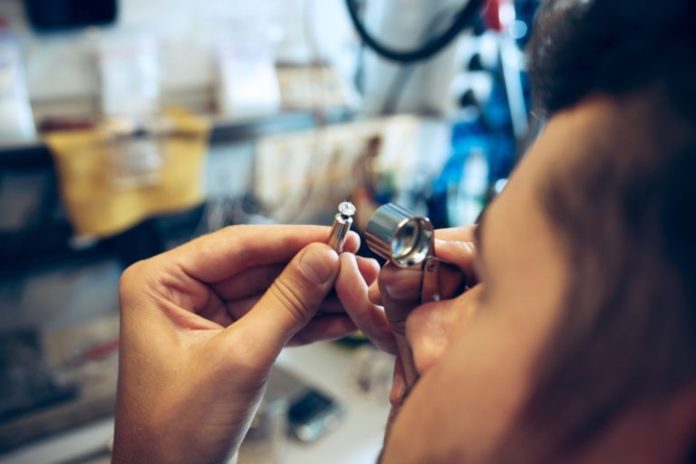One of the newest trends in the diamond market has been the need to create ethical jewelry with ethically sourced diamonds. In the past, people were more concerned with the beauty and quality of the diamond rather than where it came from.
However, because diamonds have been in the middle of bloodshed and because mining diamonds can be an environmental hazard, you may be reluctant to buy diamonds the old-fashioned way.
Here is some information about how you can make sure you buy ethically sourced diamonds to improve both the environment as well as the working conditions of others.
Where do diamonds come from?
Natural diamonds are made deep inside the earth, in the earth’s mantle. Graphite, which is composed mostly of carbon, is put under extreme heat and pressure. Over time, the heat and pressure make a hard substance where the carbon atoms are stacked in a pattern.
These rare objects are mined from the ground as diamonds. You may not know that diamond mining takes place in only a few countries, which is one reason diamonds are so expensive. For example, the United States has no diamond mines. Most diamond mining takes place in Russia, Canada, and three countries in Africa, the Congo, and South Africa.
Diamond mining can be very dangerous for humans and harmful to the environment, so it’s understandable that you may have ethical objections to diamond mining. Diamond mining began in India in the 4th century and quickly became a hot commodity on the Silk Road. Diamond mining has been dangerous as long as people have been mining. Usually, you have to dig deep into the ground to get diamonds.
While large diamond manufacturing is somewhat safer, small diamond mining is dangerous. Workers can die from tunnel landslides, cave-ins, or lack of oxygen. While past generations didn’t worry as much about where their diamonds come from, today’s diamond connoisseurs want to ensure they leave the planet better than they found it.
What are blood diamonds?
Blood diamonds are called that because they are mined in a war zone. The money that is gained from purchasing blood diamonds can be used to finance wars and terrorism around the world. For example, blood diamonds have been used to fund terrorism in the Sudan and in Nigeria.
Because diamonds have been used to fund terrorism, you may not want to buy diamonds without checking to see where they came from. That way, you’ll know that your diamond purchase conforms to your personal ethics, as well as the ethics of your family or loved ones.
What are ethical or conflict-free diamonds?
In 2003, diamond manufacturers began to regulate where they purchased diamonds from. The diamond industry allotted its purchasing power to stop buying from vendors who could not provide sources for their diamonds.
Also, when diamonds are properly sourced, the diamond industry can ensure that the diamonds aren’t being mined with child labor. Diamond buyers and vendors began to ask for ethical engagement rings and conflict-free jewelry with guaranteed provenance.
If a company cannot prove where their diamonds come from and that they were mined sustainably, the jeweler will not buy from them. That way, if you do a little checking, you can be sure you and your family’s ethical engagement rings are a perfect purchase.
Transparency in the supply chain
One way you can corroborate you buy only conflict-free diamonds is to buy from a company with a supply chain that is visible to any potential buyer. In the past, jewelers did not care where they got their diamonds from.
However, today’s jewelers know that you will not want to buy diamonds from them if they cannot prove to you they were ethically sourced. Look for retail and wholesale jewelers that practice transparency in their supply chains. Look at a company’s website to see if they put information on diamond provenances on their websites.
For example, if a diamond was mined in India, you should be able to click on a link on the jeweler’s website to see where and when the diamond was mined. Some jewelers even have a way to track each diamond as it makes its way through the supply chain.
Other diamond manufacturers may show you a letter of authenticity that proves where their diamonds came from. When you are looking for conflict-free diamonds, you can ask the jeweler for proof of where and when the diamonds were mined. You may also want to do a bit of investigating on your own to determine where and when your diamonds were mined.
No use of child labor
In the past, diamond mines used child labor to mine their diamonds. Children were not only smaller, but they also had greater dexterity at their fingertips, and mining companies could pay them much smaller wages compared to the rest of their employees. In the 20th century, child labor laws were enacted in many Western countries so that children could go to school rather than work.
Also, many countries do not permit children under the age of 14 to work. However, in some countries in Africa and Asia, child labor laws don’t exist. The use of child labor goes against many people’s ethics since children deserve to be enrolled in school.
By not ensuring where your diamond comes from, you may be contributing to an ongoing cycle of poverty. To be sure your diamond is certified as a conflict-free diamond, check and make sure the diamond mine did not use child labor in the extracting process.
A minimal impact on the environment
One of the most recent concerns among consumers who are interested in buying conflict-free diamonds is that they want their diamonds to be sustainably sourced as well as ethically sourced. If it is not done properly, diamond mining can be extremely harmful to the environment. To mine diamonds, companies have to dig for diamonds deep in the ground, which can lead to deforestation and erosion.
Often, illegal diamond mining uses water and chemicals to bring the diamonds closer to the surface, which means that surface water and groundwater can be contaminated. Also, diamond mining causes lots of dust in the air, which can make it difficult to breathe. You won’t want to buy diamonds from a company that does not practice good environmental guidelines when they mine. While many mining companies flout ethical standards, there are diamond mining companies who are practicing ethical mining.
For example, some ethical mining companies replant trees and use mining practices that minimize the use of water and chemicals. They also clean up mining sites and ready them to be used in the future as farmland or grazing land. Other mining companies do not use chemicals in the diamond mining process. Be sure to ask how your diamonds were mined when you are purchasing diamond jewelry.
Why Should You Buy Conflict-Free Diamonds?
In the 20th century, most people weren’t worried about where their diamonds came from. However, today’s consumer believes in using their money to purchase diamonds from companies that practice corporate responsibility towards people as well as the environment. There are many reasons you need to make sure your diamonds are conflict-free.
First, you want to ensure that the diamonds you are looking at for an engagement ring are conflict-free. Make sure your loved one’s engagement diamond was not used to purchase arms for terrorists or provide money to warlords. Second, conflict-free diamonds do not use child labor to mine the diamonds from the ground. Third, you want to buy a conflict-free diamond that is sustainably mined by a company that is concerned about the environment.
How can you be sure that the diamond you are purchasing is ethical?
Diamond mining companies and retail jewelers have made it much easier for conscious consumers to buy conflict-free diamonds in the 21st century. If you are in the market for a diamond, ask your jeweler where the diamond comes from, and make sure they can prove it. Ask for a chain of ownership or provenance.
Also, you can ask the jeweler about their policies regarding child labor as well as their environmental practices. Reputable jewelers will be able to provide you with all of the information you need to ensure the next diamond you purchase will not only sparkle but will also come from a company that cares about the future of both people and the planet.





